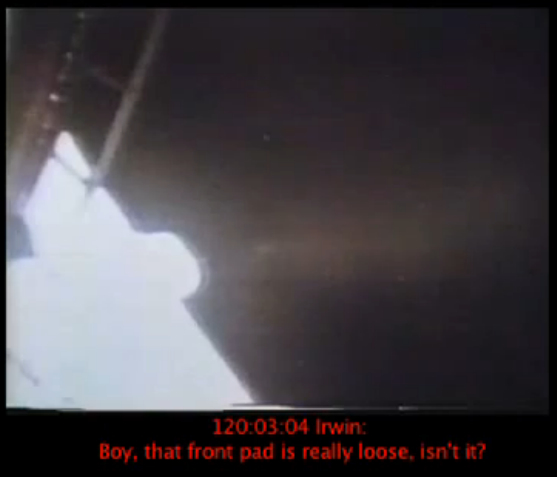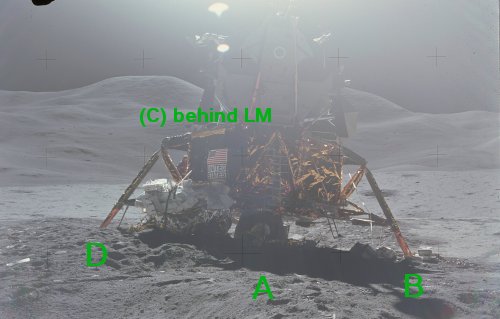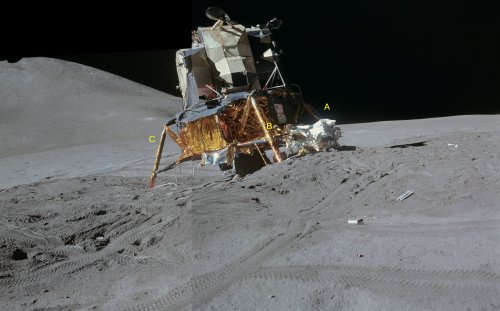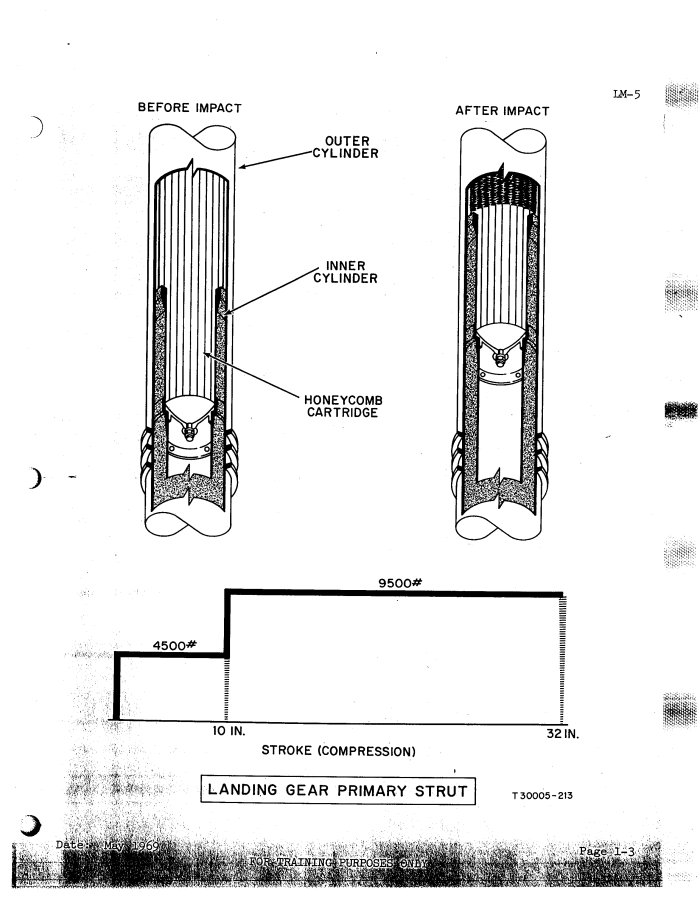It looks like you're using an Ad Blocker.
Please white-list or disable AboveTopSecret.com in your ad-blocking tool.
Thank you.
Some features of ATS will be disabled while you continue to use an ad-blocker.
share:
what the hell at that video above @ 1:44 showing the picture of the earth and the rectangular cut and paste? wtf?!
Very good thread.
However i do believe the landings happened and i believe the leg of the lander might not be moving it could be the camera being vibrated or moved slightly with his movement on the lander.
But very good videos.
However i do believe the landings happened and i believe the leg of the lander might not be moving it could be the camera being vibrated or moved slightly with his movement on the lander.
But very good videos.
Originally posted by FoosM
The first video has to do with what appears to be a broken leg on the LM.
www.youtube.com...
What appears to be a broken leg to you is actually simple mechanics called a lever and a fulcrum. You have four legs on the LM which landed on the edge of a crater. Two opposite legs formed the fulcrum and the body of the LM formed a lever. It actually acted just like a playground toy called a "teeter-totter". Because the two opposite legs were slightly higher than the other two legs, the "teeter-totter" was formed. When the astronauts stepped off the ladder onto the ground, it removed the offset weight distribution and allowed the LM to teeter on the fulcrum formed by the two opposite legs. Also, any time the astronauts interacted with the ladder, they activated the "teeter-totter" affect. Simple as that.
Besides, how does your premise of a broken leg prove the Moon landings were a hoax? Simple mechanics explains it all. No hoax involved.
Originally posted by Gibborium
Originally posted by FoosM
The first video has to do with what appears to be a broken leg on the LM.
www.youtube.com...
What appears to be a broken leg to you is actually simple mechanics called a lever and a fulcrum. You have four legs on the LM which landed on the edge of a crater. Two opposite legs formed the fulcrum and the body of the LM formed a lever. It actually acted just like a playground toy called a "teeter-totter". Because the two opposite legs were slightly higher than the other two legs, the "teeter-totter" was formed. When the astronauts stepped off the ladder onto the ground, it removed the offset weight distribution and allowed the LM to teeter on the fulcrum formed by the two opposite legs. Also, any time the astronauts interacted with the ladder, they activated the "teeter-totter" affect. Simple as that.
Besides, how does your premise of a broken leg prove the Moon landings were a hoax? Simple mechanics explains it all. No hoax involved.
It's not a teeter-totter but the front pad is really loose. Why are you trying to turn this into a teeter-tooter when Jim Irwin clearly stated that the "front pad is really loose"? And Dave Scott agreed with him in the video.
The foot pad loose is not the only thing loose on this Apollo 15 video. But the entire ladder, supposedly it was welded to the landing strut, is visibly loose when Dave Scott and Jim Irwin climbed down the LEM.

Nothing but *crickets* so far.
Foos, I appreciate your video's. I know you realize you're posting this information in the lair of the beast. That's why I'm really surprised there hasn't been a decent challenge to your videos. Thank you for speaking truth.
Now, please, I want to see part 4, 5, 6, 7, and more! Excellent work!
Foos, I appreciate your video's. I know you realize you're posting this information in the lair of the beast. That's why I'm really surprised there hasn't been a decent challenge to your videos. Thank you for speaking truth.
Now, please, I want to see part 4, 5, 6, 7, and more! Excellent work!
reply to post by SayonaraJupiter
You do realize that the pad was made to swivel so that it would make full contact with the surface. If this pad was not making solid contact with the ground, it would naturally feel "loose" as discussed by both astronauts.
However, the legs themselves were designed with a honeycomb material inside which would crush if too much pressure was placed on the pad/leg. Combine this with the fact that they landed on the edge of a slope/crater which caused a "teeter-totter" affect. Shown in the picture below, legs B and D were on the edge of the crater. Leg A, with the ladder attached and leg C, located behind were not completely in contact with the Moon's surface. Hence, the LM would "teeter" on the fulcrum created by legs B and D. Again, this is simple mechanics and should be understood by anyone with a modicum of sense.

In the video provided by FoosM you can see the ladder, the leg and the struts all move in unison at the point where he indicates "Dave hit the ladder so hard he actually moved the LM . . .". It wasn't just the ladder that moved. And when it comes to lifting the "entire" LM, when an object is balanced on the fulcrum point, it takes very minimal pressure to move the object on that point.
There is no problem here, Houston, only a wobbly LM due not making full contact with all four pads/legs.
It's not a teeter-totter but the front pad is really loose. Why are you trying to turn this into a teeter-tooter when Jim Irwin clearly stated that the "front pad is really loose"? And Dave Scott agreed with him in the video.
The foot pad loose is not the only thing loose on this Apollo 15 video. But the entire ladder, supposedly it was welded to the landing strut, is visibly loose when Dave Scott and Jim Irwin climbed down the LEM.
You do realize that the pad was made to swivel so that it would make full contact with the surface. If this pad was not making solid contact with the ground, it would naturally feel "loose" as discussed by both astronauts.
However, the legs themselves were designed with a honeycomb material inside which would crush if too much pressure was placed on the pad/leg. Combine this with the fact that they landed on the edge of a slope/crater which caused a "teeter-totter" affect. Shown in the picture below, legs B and D were on the edge of the crater. Leg A, with the ladder attached and leg C, located behind were not completely in contact with the Moon's surface. Hence, the LM would "teeter" on the fulcrum created by legs B and D. Again, this is simple mechanics and should be understood by anyone with a modicum of sense.

In the video provided by FoosM you can see the ladder, the leg and the struts all move in unison at the point where he indicates "Dave hit the ladder so hard he actually moved the LM . . .". It wasn't just the ladder that moved. And when it comes to lifting the "entire" LM, when an object is balanced on the fulcrum point, it takes very minimal pressure to move the object on that point.
There is no problem here, Houston, only a wobbly LM due not making full contact with all four pads/legs.
Originally posted by Gibborium
reply to post by SayonaraJupiter
It's not a teeter-totter but the front pad is really loose. Why are you trying to turn this into a teeter-tooter when Jim Irwin clearly stated that the "front pad is really loose"? And Dave Scott agreed with him in the video.
The foot pad loose is not the only thing loose on this Apollo 15 video. But the entire ladder, supposedly it was welded to the landing strut, is visibly loose when Dave Scott and Jim Irwin climbed down the LEM.
You do realize that the pad was made to swivel so that it would make full contact with the surface. If this pad was not making solid contact with the ground, it would naturally feel "loose" as discussed by both astronauts.
However, the legs themselves were designed with a honeycomb material inside which would crush if too much pressure was placed on the pad/leg. Combine this with the fact that they landed on the edge of a slope/crater which caused a "teeter-totter" affect. Shown in the picture below, legs B and D were on the edge of the crater. Leg A, with the ladder attached and leg C, located behind were not completely in contact with the Moon's surface. Hence, the LM would "teeter" on the fulcrum created by legs B and D. Again, this is simple mechanics and should be understood by anyone with a modicum of sense.
In the video provided by FoosM you can see the ladder, the leg and the struts all move in unison at the point where he indicates "Dave hit the ladder so hard he actually moved the LM . . .". It wasn't just the ladder that moved. And when it comes to lifting the "entire" LM, when an object is balanced on the fulcrum point, it takes very minimal pressure to move the object on that point.
There is no problem here, Houston, only a wobbly LM due not making full contact with all four pads/legs.
Do you have a source that backs up these claims?
However, the legs themselves were designed with a honeycomb material inside which would crush if too much pressure was placed on the pad/leg. Combine this with the fact that they landed on the edge of a slope/crater which caused a "teeter-totter" affect.
More specifically, the claim that they landed on the edge of a slope/crater. I would assume that the last place the lander would want to land would be at the edge of a slope/crater. I'm sure that they planned never to land at such a compromising position, so I'm more than curious about your source for this information. Thanks!
edit on 31-12-2012 by Enlightenme1111 because: (no reason given)
If the Apollo 15 landing module was unstable, like a teeter-totter, why didn't they do anything to correct that situation?
edit on 1/4/2013 by
SayonaraJupiter because: (no reason given)
Great videos.
The whole notion of man landing, walking and playing golf on the moon in 1969 (knowing what we know now) is ludicrous. There are a million things that could go wrong with a moon landing yet NASA would have us believe it all went smoothly, without a hitch, and we safely returned to earth
Meh, doesnt matter what anyone presents here though, there will always be those that WANT to believe we did it & will refuse to accept the obvious.
The whole notion of man landing, walking and playing golf on the moon in 1969 (knowing what we know now) is ludicrous. There are a million things that could go wrong with a moon landing yet NASA would have us believe it all went smoothly, without a hitch, and we safely returned to earth
Meh, doesnt matter what anyone presents here though, there will always be those that WANT to believe we did it & will refuse to accept the obvious.
Originally posted by Enlightenme1111
Do you have a source that backs up these claims?
More specifically, the claim that they landed on the edge of a slope/crater. I would assume that the last place the lander would want to land would be at the edge of a slope/crater. I'm sure that they planned never to land at such a compromising position, so I'm more than curious about your source for this information. Thanks!
Take a look at the picture below. It is a composite of AS-87-11818 and AS15-87-11819.
Yes, it is a poorly stitched composite, but it will suffice.

As you can see, the LM is sitting at an incline of approximately 15+ degrees. The LM is also sitting in a depression with legs A, C, D in that depression. Leg B is sitting on the slope of a mound. Because of this mound, legs B and D form a fulcrum axis which does not allow legs A and C to make full contact with the surface. This is where the "teeter-totter" (my term) affect occurs. This would allow the up and down movement of legs A and C.
Now add the fact that the landing struts were designed with a honeycomb cartridge that would collapse in a one time use and would also create some play in the landing struts.

This and alot of other great information can be found in the Lunar Module Structures Handbook.
The shear abundance of information that has been produced by NASA and all the other industries involved is a strong proof of the space programs authenticity, including Apollo. The designs work. The technology is sound. The science and math support it. So again, I ask how does a 'broken leg" anomaly prove Apollo fraudulent?
Originally posted by Gibborium
The shear abundance of information that has been produced by NASA and all the other industries involved is a strong proof of the space programs authenticity, including Apollo. The designs work. The technology is sound. The science and math support it. So again, I ask how does a 'broken leg" anomaly prove Apollo fraudulent?
How did Commander Dave Scott account for the teeter-tooter effect when he launched from the lunar surface 3 days later ?
edit on 1/10/2013 by SayonaraJupiter because: tags
new topics
-
ILLUMINATION: Dimensions / Degrees – Da Vincis Last Supper And The Philosophers Stone
Secret Societies: 2 hours ago -
Just Sick of It! Done! Can't take it anymore!
General Chit Chat: 3 hours ago -
Speaking of Pandemics
General Conspiracies: 5 hours ago -
Stuck Farmer And His Queue Jumping Spawn
Rant: 5 hours ago
top topics
-
Joe Biden gives the USA's Highest Civilian Honor Award to Hillary Clinton and George Soros.
US Political Madness: 16 hours ago, 14 flags -
Winter Storm
Fragile Earth: 16 hours ago, 7 flags -
Paradox of Progress
Ancient & Lost Civilizations: 13 hours ago, 6 flags -
Speaking of Pandemics
General Conspiracies: 5 hours ago, 6 flags -
ILLUMINATION: Dimensions / Degrees – Da Vincis Last Supper And The Philosophers Stone
Secret Societies: 2 hours ago, 5 flags -
Just Sick of It! Done! Can't take it anymore!
General Chit Chat: 3 hours ago, 3 flags -
Stuck Farmer And His Queue Jumping Spawn
Rant: 5 hours ago, 2 flags
active topics
-
Joe Biden gives the USA's Highest Civilian Honor Award to Hillary Clinton and George Soros.
US Political Madness • 31 • : charlest2 -
Just Sick of It! Done! Can't take it anymore!
General Chit Chat • 4 • : Flyingclaydisk -
Musk calls on King Charles III to dissolve Parliament over Oldham sex grooming gangs
Mainstream News • 122 • : andy06shake -
Winter Storm
Fragile Earth • 22 • : RickinVa -
Matthew Livelsberger said he was being followed by FBI
Political Conspiracies • 70 • : CarlLaFong -
Paranoid Liberals Believe U.S. Service Members are More Dangerous than Illegal Aliens.
Social Issues and Civil Unrest • 46 • : Xtrozero -
Orbs Appear And Form Triangle On Live Cam.
Aliens and UFOs • 26 • : mysterioustranger -
NJ Drones tied to Tesla explosion at Trump Las vegas
General Conspiracies • 49 • : Skinnerbot -
ILLUMINATION: Dimensions / Degrees – Da Vincis Last Supper And The Philosophers Stone
Secret Societies • 2 • : network dude -
Tesla Cybertruck Explodes in Front of Trump Hotel in Las Vegas
Mainstream News • 223 • : CarlLaFong
